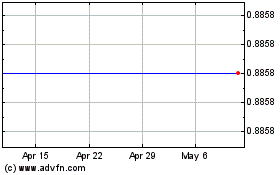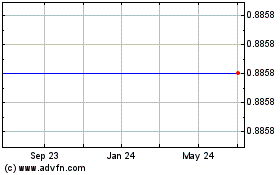Index Giant S&P Settles Charges Over Volatility Gauge -- Update
May 17 2021 - 5:09PM
Dow Jones News
By Gunjan Banerji
The Securities and Exchange Commission charged S&P Dow Jones
Indices LLC forwith failing to properly oversee a
volatility-related index that landed at the center of market
turmoil in February 2018.
The civil charge pertains to the S&P 500 VIX Short Term
Futures Index, which fed into the VelocityShares Daily Inverse VIX
Short Term Exchange-Traded Note. The once-popular exchange-traded
note, overseen by Credit Suisse Group AG, left investors with big
losses during a bout of market volatility.
Exchange-traded products based on volatility swelled in
popularity over the past decade, and the Credit Suisse note, known
by its ticker XIV, had been a favorite among investors who sought
to profit from a decline in volatility -- a lucrative but dangerous
wager.
In February 2018, the note faced big losses as volatility roared
back, and the central role that exchange-traded products like XIV
played led the period to be called " Volmageddon." The SEC's latest
charges reveal how the index behind the product was riddled with
problems.
The SEC said S&P Dow Jones Indices didn't have enough people
available to monitor the index and didn't follow the company's
procedures for index monitoring. S&P agreed to pay a $9-million
penalty to settle the charges with the regulator.
S&P didn't admit or deny the SEC's allegations. S&P said
in a statement that it "has reviewed its methodologies and its
related policies and procedures as part of its index governance
processes." A spokeswoman for Credit Suisse declined to
comment.
S&P Dow Jones Indices oversaw the index on Monday, Feb. 5,
2018, when the S&P 500 logged a steep drop and the Cboe
Volatility Index recorded its biggest jump in history. The index
was supposed to track VIX futures contracts.
After markets closed that day, the VIX futures contracts surged.
However, the S&P index experienced an "auto hold" at times,
freezing the value of the index. But the feature that allowed the
index to freeze for certain periods had never been publicly
disclosed, leading to stale index values and calculations for XIV.
Instead of disseminating values that were based on real-time VIX
futures prices, there were static index values being
disseminated.
"Despite this notable market volatility on February 5, the Index
remained static during certain intervals between the 4:00 p.m. hour
up until 5:08 p.m., even though it was supposed to calculate values
based on real-time prices of certain VIX futures contracts," the
SEC's order states.
Additionally, provisions in XIV allowed Credit Suisse to
"accelerate" the outstanding notes and effectively shut down the
product. The stale index values means that XIV's values that day
were lower than what was being reported to investors and could be
accelerated -- which investors didn't know at the time.
"As such, during the 4:00 p.m. hour and until 5:09 p.m., when
the closing indicative value of XIV was published, investors did
not know that they had been purchasing and/or holding a product
that had an economic value that was substantially less than what
XIV's calculation agent had publicly reported and that was at risk
of being accelerated by its issuer," the order says.
Credit Suisse decided to shut down the product shortly
after.
S&P Dow Jones Indices is a joint venture of S&P Global
and exchange operator CME Group. Dow Jones, the publisher of The
Wall Street Journal, was previously a part-owner of S&P Dow
Jones Indices but sold its last remaining stake in the unit to CME
in 2013. A spokesman for CME declined to comment.
S&P Dow Jones Indices manages thousands of indexes,
including the S&P 500 and the Dow Jones Industrial Average. The
company licenses its indexes to fund managers and exchanges that
offer ETFs and other products based on its indexes.
Write to Gunjan Banerji at Gunjan.Banerji@wsj.com
(END) Dow Jones Newswires
May 17, 2021 16:54 ET (20:54 GMT)
Copyright (c) 2021 Dow Jones & Company, Inc.
Credit Suisse (NYSE:CS)
Historical Stock Chart
From Mar 2024 to Apr 2024

Credit Suisse (NYSE:CS)
Historical Stock Chart
From Apr 2023 to Apr 2024
